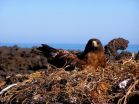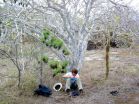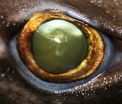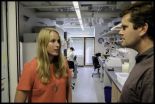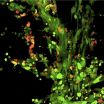(Press-News.org) Say what you will about the parasitic lifestyle, but in the evolution of life on Earth, it's a winner.
Given that about half of all known species are parasites, biologists have long hypothesized that the strategy of leeching off other organisms is a major driver of biodiversity. Studying populations of Galápagos hawks (Buteo galapagoensis) and feather lice that live in their plumage (Degeeriella regalis), a group led by University of Arizona ecologists and evolutionary biologists has gathered some of the first field evidence suggesting that a phenomenon called co-divergence between parasites and hosts is indeed an important mechanism driving the evolution of biodiversity.
"The idea is really simple," said the study's lead author, Jennifer Koop, who is a postdoctoral fellow in the lab of Noah Whiteman in the UA's Department of Ecology and Evolutionary Biology. "Each time a host population splits into separate populations that potentially become different species, we predict that their parasites could do the same thing."
However, biologists have long struggled to test this hypothesis, as parasites are elusive.
"Often, the evolutionary trees of parasites and their hosts are congruent – they look like mirror images of one another," said Whiteman, who is an assistant professor in EEB, a joint assistant professor in the Department of Entomology and the School of Plant Sciences, and a member of the UA's BIO5 Institute. "But because parasites tend to be inside or attached to hosts, their distributions are difficult to study."
"We found the lice are passed on from mother to babies during brooding, almost like genes," Whiteman said. "They're evolutionary heirlooms, like your family's silverware or engagement ring diamond."
Because the hawks pass on the feather lice from generation to generation, the researchers wanted to know whether the louse populations diverge between populations of hawks and between individual hawks, or whether the populations of the birds and the lice diverged independently of each other.
Remarkably, the findings, which are published in the journal Biology Letters of the Royal Society, revealed that the population structure of the lice matched that of the birds across the archipelago, even though the two are very different species.
"To the lice, each bird is an island, and their populations are very different from bird to bird," Whiteman said. "The same pattern is repeated between bird populations on different islands. It's like Russian dolls."
In other words, the lice living on any one bird and its offspring are more closely related than the lice living on a different bird. As the birds diversify into distinct populations on each island, their parasites diversify with them. The findings help explain the rapid rate of parasite evolution, according to the research team.
"You have to be in the right spot at the right time to see this process happening," Koop said. "Our study empirically demonstrates an important evolutionary process in which the hawks separate into different populations, and the lice living on them do the same."
This process is hypothesized to lead to the formation of different species, in this case different species of hawks and lice, and may explain some of the extraordinary diversity seen among parasites, she said.
The team chose the Galápagos Islands, located 575 miles off the west coast of Ecuador, for the study because the species that colonized the geologically young group of islands have evolved in isolation, making the area an ideal natural laboratory.
"Of all the vertebrate species native to the Galápagos, the Galápagos hawk is the most recent arrival," Whiteman said. "So whatever is happening in terms of evolution of the bird population and the parasite population is most likely in the earliest stages of that process."
In four years of fieldwork on eight major islands, the team caught hundreds of Galápagos hawks – which later were released unharmed – and collected blood samples and feather lice for genomic analysis, in a partnership with the Galápagos National Park. Whiteman said the hawks' lice are specialized on their host species and the feathers they consume, and unable to survive on any other species.
Co-authors Karen DeMatteo and Patricia Parker, both at the Department of Biology at the University of Missouri-St. Louis, then used the DNA from the samples to generate a genetic fingerprint of each population. Parker helped with the fieldwork.
A better understanding of how parasites and their hosts coevolve has implications for biomedical sciences, according to Whiteman. In addition, it can help researchers who study parasites as evolutionary tags of the host species.
"The fact that we were able to work with these birds, which are the top predators in their habitat, and reveal some answers to fundamental questions in biology shows why such places should continue to be preserved," Whiteman said.
INFORMATION:
The paper, "Birds are islands for parasites," is available at http://rsbl.royalsocietypublishing.org/content/10/8/20140255.abstract
Galápagos hawks hand down lice like family heirlooms
Study provides some of the first evidence for the hypothesis of co-divergence between parasites and hosts acting as a major driver of biodiversity
2014-08-06
ELSE PRESS RELEASES FROM THIS DATE:
NASA's Hubble finds supernova star system linked to potential 'zombie star'
2014-08-06
Using NASA's Hubble Space Telescope, a team of astronomers has spotted a star system that could have left behind a "zombie star" after an unusually weak supernova explosion.
A supernova typically obliterates the exploding white dwarf, or dying star. On this occasion, scientists believe this faint supernova may have left behind a surviving portion of the dwarf star -- a sort of zombie star.
While examining Hubble images taken years before the stellar explosion, astronomers identified a blue companion star feeding energy to a white dwarf, a process that ignited a nuclear ...
New research links tornado strength, frequency to climate change
2014-08-06
TALLAHASSEE, Fla. — New research by a Florida State University geography professor shows that climate change may be playing a key role in the strength and frequency of tornadoes hitting the United States.
Published Wednesday in the journal Climate Dynamics, Professor James Elsner writes that though tornadoes are forming fewer days per year, they are forming at a greater density and strength than ever before. So, for example, instead of one or two forming on a given day in an area, there might be three or four occurring.
"We may be less threatened by tornadoes on a ...
Fipronil and imidacloprid reduce honeybee mitochondrial activity
2014-08-06
PENSACOLA, Fla. — New research published in Environmental Toxicology and Chemistry addresses the effects of two broad-spectrum systemic insecticides, fipornil and imidacloprid, on honeybees. These insecticides are widely used in agriculture, and the authors conclude that fipronil and imidacloprid are inhibitors of mitochondrial bioenergetics, resulting in depleted cell energy. This action can explain the toxicity of these compounds for honeybees.
Scientists are urgently trying to determine the causes of colony collapse disorder and the alarming population declines of ...
Community religious beliefs influence whether wives work outside home, Baylor study finds
2014-08-06
Married women who live in communities in which a higher proportion of the population belongs to conservative religious traditions — such as evangelical or Mormon — are more likely to choose not to work outside the home, even if the women are not members of those faith groups, according to a Baylor University study.
The study — "Work-Family Conflict: The Effects of Religious Context on Married Women's Participation in the Labor Force" — appears in the journal Religions in a special issue, "Religion, Spirituality, and Family Life."
While previous research has shown individual ...
Photon hunting in the twilight zone
2014-08-06
The eyes of deep-sea bioluminescent sharks have a higher rod density when compared to non-bioluminescent sharks, according to a study published August 6, 2014 in the open-access journal PLOS ONE by Julien M. Claes, postdoctoral researcher from the FNRS at Université catholique de Louvain (Belgium), and colleagues. This adaptation is one of many these sharks use to produce and perceive bioluminescent light in order to communicate, find prey, and camouflage themselves against predators.
The mesopelagic twilight zone, or about 200-1000 meters deep in the sea, is a vast, ...
Young loggerhead turtles not going with the flow
2014-08-06
Juvenile loggerhead turtles swim into oncoming ocean currents, instead of passively drifting with them, according to a study published August 6, 2014 in the open-access journal PLOS ONE by Donald Kobayashi from National Oceanic and Atmospheric Administration and colleagues.
After loggerhead turtle hatchlings leave nesting beaches, they live in the ocean for 7-12 years before migrating to coastal habitats. Juvenile loggerhead turtles have good swimming abilities, but scientists aren't sure if they passively drift in ocean currents or actively swim. Combining turtle movement ...
HSCI researchers identify another potential ALS treatment avenue
2014-08-06
Cambridge, MA, Aug 6 - A series of studies begun by Harvard Stem Cell Institute (HSCI) scientists eight years ago has lead to a report published today that may be a major step forward in the quest to develop real treatments for amyotrophic lateral sclerosis, ALS, or Lou Gehrig's disease.
The findings by Harvard professor of Stem Cell and Regenerative Biology (HSCRB) Kevin Eggan and colleagues also has produced functionally identical results in human motor neurons in a laboratory dish and in a mouse model of the disease, demonstrating that the modeling of human disease ...
Dr. Brenna Anderson publishes commentary in BJOG
2014-08-06
Brenna Anderson, MD, of the Division of Maternal-Fetal Medicine at Women & Infants of Rhode Island and an associate professor of obstetrics and gynecology at The Warren Alpert Medical School of Brown University, has published a commentary in the current issue of BJOG: An International Journal of Obstetrics and Gynaecology, now available online. The commentary is entitled "The time has come to consider neonatal outcomes when designing embryo transfer policies."
Dr. Anderson offers her commentary in response to an article in the same issue by Kamphius et al. in which the ...
Brain tumors fly under the body's radar like stealth jets, new U-M research suggests
2014-08-06
ANN ARBOR, Mich. — Brain tumors fly under the radar of the body's defense forces by coating their cells with extra amounts of a specific protein, new research shows.
Like a stealth fighter jet, the coating means the cells evade detection by the early-warning immune system that should detect and kill them. The stealth approach lets the tumors hide until it's too late for the body to defeat them.
The findings, made in mice and rats, show the key role of a protein called galectin-1 in some of the most dangerous brain tumors, called high grade malignant gliomas. A research ...
NIST ion duet offers tunable module for quantum simulator
2014-08-06
BOULDER, Colo -- Physicists at the National Institute of Standards and Technology (NIST) have demonstrated a pas de deux of atomic ions that combines the fine choreography of dance with precise individual control.
NIST's ion duet, described in the August 7 issue of Nature, is a component for a flexible quantum simulator that could be scaled up in size and configured to model quantum systems of a complexity that overwhelms traditional computer simulations. Beyond simulation, the duet might also be used to perform logic operations in future quantum computers, or as a quantum-enhanced ...
LAST 30 PRESS RELEASES:
Tracing the quick synthesis of an industrially important catalyst
New software sheds light on cancer’s hidden genetic networks
UT Health San Antonio awarded $3 million in CPRIT grants to bolster cancer research and prevention efforts in South Texas
Third symposium spotlights global challenge of new contaminants in China’s fight against pollution
From straw to soil harmony: International team reveals how biochar supercharges carbon-smart farming
Myeloma: How AI is redrawing the map of cancer care
Manhattan E. Charurat, Ph.D., MHS invested as the Homer and Martha Gudelsky Distinguished Professor in Medicine at the University of Maryland School of Medicine
Insilico Medicine’s Pharma.AI Q4 Winter Launch Recap: Revolutionizing drug discovery with cutting-edge AI innovations, accelerating the path to pharmaceutical superintelligence
Nanoplastics have diet-dependent impacts on digestive system health
Brain neuron death occurs throughout life and increases with age, a natural human protein drug may halt neuron death in Alzheimer’s disease
SPIE and CLP announce the recipients of the 2025 Advanced Photonics Young Innovator Award
Lessons from the Caldor Fire’s Christmas Valley ‘Miracle’
Ant societies rose by trading individual protection for collective power
Research reveals how ancient viral DNA shapes early embryonic development
A molecular gatekeeper that controls protein synthesis
New ‘cloaking device’ concept to shield sensitive tech from magnetic fields
Researchers show impact of mountain building and climate change on alpine biodiversity
Study models the transition from Neanderthals to modern humans in Europe
University of Phoenix College of Doctoral Studies releases white paper on AI-driven skilling to reduce burnout and restore worker autonomy
AIs fail at the game of visual “telephone”
The levers for a sustainable food system
Potential changes in US homelessness by ending federal support for housing first programs
Vulnerability of large language models to prompt injection when providing medical advice
Researchers develop new system for high-energy-density, long-life, multi-electron transfer bromine-based flow batteries
Ending federal support for housing first programs could increase U.S. homelessness by 5% in one year, new JAMA study finds
New research uncovers molecular ‘safety switch’ shielding cancers from immune attack
Bacteria resisting viral infection can still sink carbon to ocean floor
Younger biological age may increase depression risk in older women during COVID-19
Bharat Innovates 2026 National Basecamp Showcases India’s Most Promising Deep-Tech Ventures
Here’s what determines whether your income level rises or falls
[Press-News.org] Galápagos hawks hand down lice like family heirloomsStudy provides some of the first evidence for the hypothesis of co-divergence between parasites and hosts acting as a major driver of biodiversity
